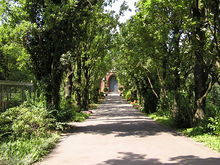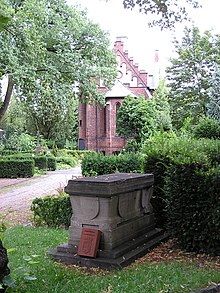Grunewald cemetery
The Grunewald cemetery was laid out in 1891/92 for the Berlin villa colony Grunewald . It is located at the Bornstedter Road 11/12 in the district Halensee the district Charlottenburg-Wilmersdorf . Because of its isolated location between train tracks, the cemetery is also called the island of the dead .
history

For the villa colony Grunewald founded in the 1880s, the 11,686 m² site northwest of Bornstedter Straße was selected as a cemetery in 1891. Even at this point in time, the site was surrounded by railroad tracks, so that access could only be established by means of a bridge over a railroad track. This remote location gave the cemetery the popular name of the island of the dead .

On May 19, 1892, the cemetery, laid out according to plans by the royal garden inspector Roer, was opened. From the entrance, the main path leads through an avenue of pyramid oaks straight to the cemetery chapel, built in 1897 in neo-Gothic style . According to designs by Carl Zaar and Rudolf Vahl , the chapel was extended by a vestibule in 1902/03.
The path network of the cemetery still has the structure that was laid out when it was opened. The cemetery stands as a garden monument under monument protection .
Well-known personalities buried
The villa colony of Grunewald, one of the noblest residential areas in Berlin, led to numerous successful scientists, entrepreneurs and artists being buried in the Grunewald cemetery. Well-known personalities among them are (sorted alphabetically):

(* = Honorary grave of the state of Berlin, ° = former honorary grave of the state of Berlin)
- Franz Ahrens (1858–1937), architect, location unknown or already leveled
- Gustav Ahrens (1860–1914), banker, location: Dept. I-Erb-33
- Jack O. Bennett (1914–2001), first pilot of the Berlin Airlift , location: Dept. I-80
- Hermann Berthold (1831–1904), inventor of the normal typography system , founder of the Berthold type foundry , location: Section IV, already leveled
- Alfred Blaschko ° (1858–1922), dermatologist and sex researcher, location: Section V, already leveled
- Alexander Conze (1831–1914), archaeologist, location: Section III, already leveled
- Víctor Cruz (1908–1998), bass player and singer, location: Abt. I-Erb-41
- Hans Delbrück * (1848–1929), historian, location: Section III 1-8 / 10
- Bernhard Dernburg (1865–1937), political scientist and politician, location: Dept. IV Erb 17
- Ernst Dernburg (1887–1960), actor and director, location: Section IV, already leveled
- Friedrich Dernburg * (1832–1911), writer and member of the Reichstag , location: Section III
- Alfred Dietrich (1843–1898), shipbuilding engineer, location: Section I, already leveled
- Georg Elwert (1947–2005), ethnologist, location: Dept. III
- Bernhard Felisch (1839–1912), architect, building contractor and member of the Prussian House of Representatives, location: Section IV, already leveled
- Alfred Gaedertz (1853–1907), railway construction engineer, location: III grid 47/48
- Albert Gilka (1870–1924), liqueur manufacturer, location: Dept. V
- Carl Paul Goerz * (1854–1923), entrepreneur, founder of the optical institute CP Goerz , location: Dept. III
- Arthur Heffter (1859–1925), doctor and pharmacologist, location: Dept. V, already leveled
- Oscar Hertwig (1849–1922), biologist and anatomist, location: Dept. V, already leveled
- Martin Langen (1866–1926), writer, location: Dept. V Erb 73
- Rolf Lauckner (1887–1954), writer
- Jürgen Leinemann (1937–2013), journalist, location: Dept. V Erb 64b
- Ludwig Leo (1924–2012), architect, location: Section IV
- Otto Lessing * (1846–1912), sculptor (great-great-nephew of Gotthold Ephraim Lessing ), location: Section IV
- Felix Lindhorst (1867–1955), architect, location unknown or already leveled
- Heinrich Löhe (1877–1961), dermatologist and university professor
- Harro Magnussen (1861–1908), sculptor, location: Section II, already leveled
- Oswald Meichsner (1921–1985), draftsman and caricaturist, location: III 1-15 / 16
- Johannes Mühlenbruch (1855–1932), history painter, location: III Erb 10
- Annemarie von Nathusius (1874–1926), writer, unknown or already leveled
- Johannes Orth (1847–1923), pathologist, location: Dept. I Erb 30
- Hermann Rietschel (1847–1914), founder of heating and air conditioning technology, location: Dept. IV
- Emanuel Scharfenberg (1932–2006), sculptor, location: Abt. V
- Richard Schöne (1840–1922), archaeologist and general director of the Prussian museums, location: Dept. V, already leveled
- Robert Friedrich Karl Scholtz (1877–1956), painter and graphic artist, today resting place of the Lichtfuß family, location: Dept. V 3-14
- Hermann Amandus Schwarz (1843–1921), mathematician, location: Section II, already leveled
- Detlev Schwennicke (1930–2012), pastor and genealogist, location: Section IV
- Clara Sudermann (1861–1924), writer, location: Dept. V
- Hermann Sudermann * (1857–1928), writer, location: Dept. V 1-58 / 59
- Gerburg Treusch-Dieter (1939–2006), sociologist and cultural scientist, location: Dept. IV
- Walther Waldschmidt (1860–1932), Counselor, General Director of Ludwig Loewe & Co. , Location: Dept. V Erb 70
- Kurt Warnekros (1882–1949), gynecologist, location: Dept. V 2-4
- Bernhard Wieck (1845–1913), first head of the office and community of Grunewald, location: Dept. II, Erb. 58
Funerary artworks
The grave of Ernst von Möllers was designed by Fritz Schumacher , a founding member of the Deutscher Werkbund . A square wall made of shell limestone is divided into three fields with protruding pillars for the names of the deceased. The pillars are adorned with vine tendrils and at the head of the name fields there are allegorical motifs.
The colorful glass mosaic for Fritz Dernburg's tomb is particularly unusual for a cemetery . This died in childhood. Max Seliger, the brother of the mother of the deceased child, designed the mosaic, which shows two women dressed in white at an altar. The altar bears the often used funeral motto "Love never ceases" ( Corinthians 13 : 8). One of the women places vases of red tulips on the altar, while the other plays a harp , which a putti with brightly colored wings embraces, lost in thought. Contemporary sources report that the facial features of women are said to be modeled on those of their mother, Emma Dernburg, and her sister. The background is decorated with numerous white lilies against a dark blue. After Fritz Dernburg, other family members were buried in this tomb.
Not far from this tomb is another tomb with a mosaic that shows an angel with two palm fronds in front of a city fortification on a golden background. The mosaic shows considerable damage. This tomb was created for Therese Möbius, who died in 1896.
Meanwhile, there are also some newer, modern graves in the cemetery.
See also
literature
- Klaus Konrad Weber, Peter Güttler, Ditta Ahmadi (eds.): Funeral services . (= Berlin and its buildings , part X, volume A (systems and buildings for supply), part volume 3.) Wilhelm Ernst & Sohn, Berlin 1981, ISBN 3-433-00890-6 .
- A shadow's dream is man. Berlin cemeteries. Part 1. (CD-ROM) GBBB e. V. , Berlin 1997.
- Wolf-Rüdiger Bonk: 125 years of the Grunewald villa colony ., Berlin 2016.
Web links
- Historic cemeteries in Berlin: The Grunewald cemetery (GBBB e.V.)
- Grunewald Cemetery (Edition Luisenstadt)
- Grunewald cemetery in the lexicon of the Charlottenburg-Wilmersdorf district
- Street and Green Area Office Charlottenburg-Wilmersdorf: Interesting facts about the garden monument Grunewald cemetery. In: berlin.de. Retrieved April 24, 2020 .
- Entries in the Berlin State Monument List:
Individual evidence
- ↑ Entry in the Berlin State Monument List
- ↑ Honorary graves of the State of Berlin (as of July 2012) (PDF; 566 kB)
- ↑ according to the personal article in the family grave together u. a. with Gustav
Coordinates: 52 ° 29 ′ 56 ″ N , 13 ° 17 ′ 6 ″ E





